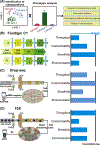Microfluidics in Single-Cell Virology: Technologies and Applications
- PMID: 32430227
- PMCID: PMC8942716
- DOI: 10.1016/j.tibtech.2020.04.010
Microfluidics in Single-Cell Virology: Technologies and Applications
Abstract
Microfluidics has proven to be a powerful tool for probing biology at the single-cell level. However, it is only in the past 5 years that single-cell microfluidics has been used in the field of virology. An array of strategies based on microwells, microvalves, and droplets is now available for tracking viral infection dynamics, identifying cell subpopulations with particular phenotypes, as well as high-throughput screening. The insights into the virus-host interactions gained at the single-cell level are unprecedented and usually inaccessible by population-based experiments. Therefore, single-cell microfluidics, which opens new avenues for mechanism elucidation and development of antiviral therapeutics, would be a valuable tool for the study of viral pathogenesis.
Keywords: heterogeneity; microfluidics; single-cell analysis; transcriptomic analysis; viral infection dynamics; virology.
Copyright © 2020 Elsevier Ltd. All rights reserved.
Figures




Similar articles
-
Single-Cell Genomics for Virology.Viruses. 2016 May 4;8(5):123. doi: 10.3390/v8050123. Viruses. 2016. PMID: 27153082 Free PMC article. Review.
-
Single-cell analysis for the study of viral inhibitors.Enzymes. 2021;49:195-213. doi: 10.1016/bs.enz.2021.07.004. Epub 2021 Aug 23. Enzymes. 2021. PMID: 34696832
-
A high-throughput drop microfluidic system for virus culture and analysis.J Virol Methods. 2015 Mar;213:111-7. doi: 10.1016/j.jviromet.2014.12.003. Epub 2014 Dec 16. J Virol Methods. 2015. PMID: 25522923
-
Human Organs-on-Chips for Virology.Trends Microbiol. 2020 Nov;28(11):934-946. doi: 10.1016/j.tim.2020.06.005. Epub 2020 Jul 13. Trends Microbiol. 2020. PMID: 32674988 Free PMC article. Review.
-
Droplet Microfluidics for High-Resolution Virology.Anal Chem. 2022 Jun 14;94(23):8085-8100. doi: 10.1021/acs.analchem.2c00615. Epub 2022 May 27. Anal Chem. 2022. PMID: 35622865
Cited by
-
Modeling poliovirus replication dynamics from live time-lapse single-cell imaging data.Sci Rep. 2021 May 5;11(1):9622. doi: 10.1038/s41598-021-87694-x. Sci Rep. 2021. PMID: 33953215 Free PMC article.
-
All the single cells: if you like it then you should put some virus on it.J Virol. 2024 Jul 23;98(7):e0127323. doi: 10.1128/jvi.01273-23. Epub 2024 Jun 21. J Virol. 2024. PMID: 38904395 Free PMC article. Review.
-
Automated microarray platform for single-cell sorting and collection of lymphocytes following HIV reactivation.Bioeng Transl Med. 2023 Jun 21;8(5):e10551. doi: 10.1002/btm2.10551. eCollection 2023 Sep. Bioeng Transl Med. 2023. PMID: 37693052 Free PMC article.
-
Methods and platforms for analysis of nucleic acids from single-cell based on microfluidics.Microfluid Nanofluidics. 2021;25(11):87. doi: 10.1007/s10404-021-02485-0. Epub 2021 Sep 22. Microfluid Nanofluidics. 2021. PMID: 34580578 Free PMC article. Review.
-
Single-cell herpes simplex virus type 1 infection of neurons using drop-based microfluidics reveals heterogeneous replication kinetics.Sci Adv. 2024 Mar;10(9):eadk9185. doi: 10.1126/sciadv.adk9185. Epub 2024 Feb 28. Sci Adv. 2024. PMID: 38416818 Free PMC article.
References
-
- Poulin J. et al. (2016) Disentangling neural cell diversity using single-cell transcriptomics. Nat. Neurosci 19, 1131–1141. - PubMed
-
- Baslan T. and Hicks J. (2017) Unravelling biology and shifting paradigms in cancer with single-cell sequencing. Nat. Rev. Cancer 17, 557–569. - PubMed
-
- Rato S. et al. (2017) Exploring viral infection using single-cell sequencing. Virus Res. 239, 55–68. - PubMed
Publication types
MeSH terms
Grants and funding
LinkOut - more resources
Full Text Sources
Miscellaneous

